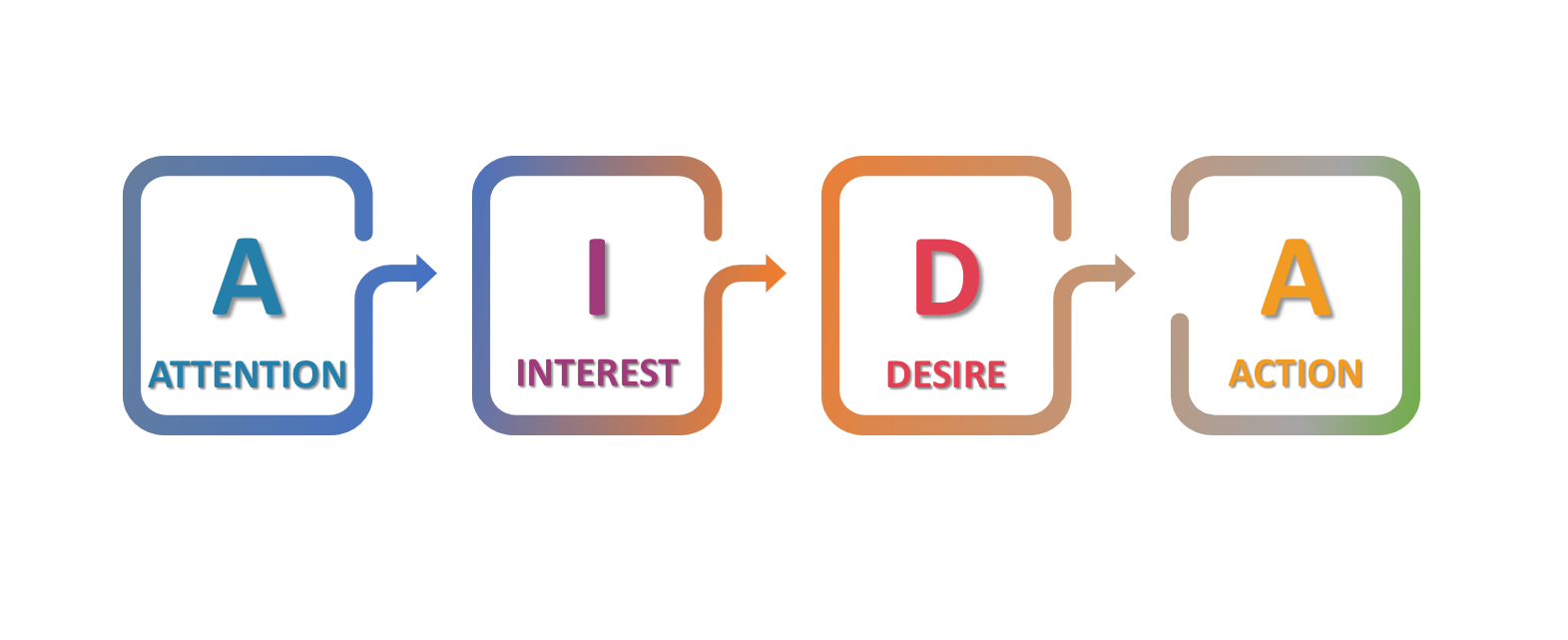AIDA Model
The AIDA model is universally used in marketing and advertising to persuade potential customers to buy a product. It describes and identifies the steps/stages from the time the consumer (individual) becomes aware of a product or a brand to the decision to make the purchase. The acronym AIDA stands for Attention, Interest, Desire and Action.

The AIDA model was introduced in the late 19th century by businessman Elias St. Elmo and have been used ever since. It is perhaps the best-known and widely used marketing model among all the classical marketing models as many marketers find it easy to apply daily when planning marketing communication strategies. The AIDA model is based on four individual stages which are:
1. Attention: also referred to as “Awareness”. creating brand awareness is an important part by many marketers, you should not assume that the consumers are already aware that the product or service exists. The product or service needs to attract the consumer’s attention, this can be done via eye-catching advertising material. This can be achieved in several ways;
- Guerrilla marketing; advertisement in unexpected situations or locations.
- Proactive imagery; creating a shock in the advertisement.
- Personalization; intensely target message to individuals.
Some of the common questions that you need to ask yourself in the attention stage are: how do I make consumers aware of our products? What tools or platforms is the most suitable for our targeted customer segment? What should our message be? What is our outreach strategy?
2. Interest: creating interest in your product, will encourage the consumer to start researching and learning further about your product or service benefits, and how it fits within his or her lifestyle. Your target audience should be able to discover your product or service through a web search, social media and other websites.
Some of the common questions that you need to ask yourself in the interest stage are: What will create the customer interest? What social proof do we have to support our brand message? Where should this information be available? How can I make it accessible and easy to find?
3. Desire: create an emotional connection between your product or service and your potential consumers. Develop a brand personality that will move the consumers from “liking” to “wanting” it. During this stage, you are trying to persuade the consumers that they want to own this product.
Infomercials do this very well. A great infomercial keeps layering on the facts and benefits until the viewers can only be amazed that they are not able not to live without this product anymore. This stage in the AIDA model is sometimes referred to as “Decision”.
Some of the questions that you need to ask yourself in this stage are: What makes our product or service desired? How are we going to create the emotional connection? e.g., personal interactions, online chat, social pages, Twitter feeds.
4. Action: this is the last stage of the AIDA model after the customer has the desire for the product, this must be transferred into action. An advertisement should end with a call to action, a statement that is designed to get an immediate response from the consumer.
One further this that need to be addressed once you have created your customer database and gained the trust is to consider retaining your customers. You need to have a proposition to retain loyalty and a clear plan on how you going to achieve this.
Further application
The AIDA model is over 100 years old and is often updated and adjusted. Today, the S of Satisfactions is often added to the AIDA model. It is the stage for repeating the buys from the existing customer. Also, remember that positive word of mouth advertising will contribute to a larger number of buyers.
AIDA model has been criticized for being too simple and not taking into consideration various possible points of sales. Marketing today is different and varies from physical locations to online stores. Therefore, many variations have to be taken into consideration of the AIDA model that needs to be taken consideration such as:
- NAITDASE (Need, Attention, Interest, Trust, Design, Action, Satisfaction, Evaluation)
- REAN (Reach, Engage, Activate, Nurture)
- AIDCAS (Action, Interest, Desire, Confidence, Action, Satisfaction)
Original reference sources:
- E. St Elmo Lewis, Financial Advertising. (The History of Advertising), USA, Levey Brothers, 1908.
- Priyanka, R., "AIDA Marketing Communication Model: Stimulating a purchase decision in the minds of the consumers through a linear progression of steps," International Journal of Multidisciplinary Research in Social Management, Vol. 1 , 2013, pp 37-44

Comments
No Comments added, be the first...